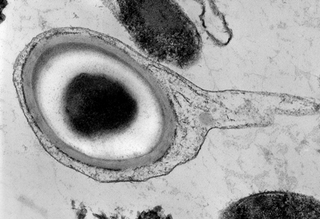Related Research Articles

Carboxydothermus hydrogenoformans is an extremely thermophilic anaerobic Gram-positive bacterium that has the interesting property of producing hydrogen as a waste product while feeding on carbon monoxide and water. It also forms endospores.

In taxonomy, Methanohalophilus is a genus of the Methanosarcinaceae.
In taxonomy, Methanomethylovorans is a genus of microorganisms with the family Methanosarcinaceae. This genus was first described in 1999. The species within it generally live in freshwater environments, including rice paddies, freshwater sediments and contaminated soil. They produce methane from methanol, methylamines, dimethyl sulfide and methanethiol. With the exception of M. thermophila, which has an optimal growth temperature of 50 °C, these species are mesophiles and do not tend to grow at temperatures above 40 °C.
Thermacetogenium phaeum is a bacterium, the type species of its genus. It is strictly anaerobic, thermophilic, syntrophic and acetate-oxidizing. Its cells are gram-positive, endospore-forming and rod-shaped. Its type strain is PBT. It has a potential biotechnological role.
Rhodothermus marinus is a species of bacteria. It is obligately aerobic, moderately halophilic, thermophilic, Gram-negative and rod-shaped, about 0.5 μm in diameter and 2-2.5 μm long.
Methanosarcina thermophila is a thermophilic, acetotrophic, methane-producing archaeon.
Thermotoga lettingae is a thermophilic, anaerobic, non-spore-forming, motile and Gram-negative bacterium, with type strain TMOT.
Fervidobacterium changbaicum is a species of thermophilic anaerobic bacteria. It is non-sporulating, motile, gram-negative, and rod-shaped. The type strain is CBS-1(T).

Methanohalophilus mahii is an obligately anaerobic, methylotrophic, methanogenic cocci-shaped archaeon of the genus Methanohalophilus that can be found in high salinity aquatic environments. The name Methanohalophilus is said to be derived from methanum meaning "methane" in Latin; halo meaning "salt" in Greek; and mahii meaning "of Mah" in Latin, after R.A. Mah, who did substantial amounts of research on aerobic and methanogenic microbes. The proper word in ancient Greek for "salt" is however hals (ἅλς). The specific strain type was designated SLP and is currently the only identified strain of this species.
Anaerolinea thermophila is a species of filamentous thermophilic bacteria, the type and only species of its genus. It is Gram-negative, non-spore-forming, with type strain UNI-1T.
Caldilinea aerophila is a species of filamentous thermophilic bacteria, and the type species of its genus. It is Gram-negative, non-spore-forming, with type strain STL-6-O1T.
Thermococcus barophilus is a barophilic and hyperthermophilic archaeon isolated from a deep-sea hydrothermal vent. It is anaerobic and sulfur-metabolising, with type strain MPT.
Nautilia lithotrophica is a thermophilic sulfur-reducing epsilon-proteobacterium isolated from a deep-sea hydrothermal vent. It is strictly anaerobic, with type strain 525T.
Carboxydocella thermautotrophica is an anaerobic, CO-utilizing thermophile bacterium. It is Gram-positive bacterium, its cells being short, straight, motile rods; its type strain is 41(T).
Thermosinus carboxydivorans is an anaerobic, thermophilic, Gram-negative, carbon-monoxide-oxidizing, hydrogenogenic bacterium, the type species of its genus. It is facultatively carboxydotrophic, curved, motile, rod-shaped, with a length of 2.6–3 μm, a width of about 0.5 μm and lateral flagellation. Its type strain is Nor1T.
Deferribacter desulfuricans is a species of sulfur-, nitrate- and arsenate-reducing thermophile first isolated from a deep-sea hydrothermal vent. It is an anaerobic, heterotrophic thermophile with type strain SSM1T.
Thermolithobacteria is a class of rod-shaped Gram-positive bacteria within phylum Firmicutes. Species within this class are thermophilic lithotrophs isolated from sediment in Calcite Springs in Yellowstone National Park. Thermolithobacter ferrireducens strain JW/KA-2(T) metabolism consists of the oxidation of hydrogen gas and reduction of ferric oxide to magnetite. Thermolithobacter carboxydivorans strain R1(T) is hydrogenic and oxidizes carbon monoxide.
Spirochaeta thermophila is a fairly recently discovered free-living, anaerobic, spirochaete that seems to be the most thermophilic of the Spirochaetales order. The type species was discovered in 1992 in Kuril islands, Russia and described in Aksenova, et al. It has been isolated in the sediments and water columns of brackish aquatic habitats of various ponds, lakes, rivers, and oceans. This organism is identified as a new species based on its unique ability to degrade cellulose, xylan, and other α- and β-linked sugars and use them as the sole carbon source by encoding many glycoside hydrolases. It is presumed to secrete cellulases to break down plant-matter around it but there has been little work on the characterization of the enzymes responsible for this.
Ancylobacter dichloromethanicus is an aerobic, Gram-negative bacteria from the family of Xanthobacteraceae which has been isolated from dichloromethane contaminated soil in Volgograd in Russia. Ancylobacter dichloromethanicus can use dichloromethane, methanol, formate and formaldehyde for its metabolism.
Methylobacterium thuringiense is a Gram-negative, aerobic, facultatively methylotrophic and rod-shaped bacteria from the genus of Methylobacterium.
References
- 1 2 B. Jiang; S. N. Parshina; W. van Doesburg; B. P. Lomans; A. J. M. Stams (2005-11-01). "Methanomethylovorans thermophila sp. nov., a thermophilic, methylotrophic methanogen from an anaerobic reactor fed with methanol" (PDF). International Journal of Systematic and Evolutionary Microbiology. 55 (6): 2465–2470. doi:10.1099/ijs.0.63818-0. ISSN 1466-5026. PMID 16280511.